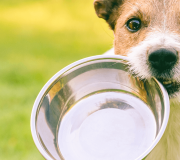Dietary Considerations for Cats with Kidney Problems
Kidney disease is one of the most common health challenges in older cats. Veterinarians use many medical management strategies to support these cats and nutritional care is also extremely important. Here are some feeding tips that can help improve the quality of life and longevity in cats with kidney problems.
1. Protein restriction doesn’t appear to be beneficial.
Board certified feline endocrinologist Mark Peterson, DVM explains that, theoretically, reduction in non-essential amino acids reduces nitrogenous waste, thereby decreasing the workload of the kidneys.4 Decreased workload in the kidneys should lead to improvement in uremia in cats with renal compromise. In reality, however, a 10-year study indicated that there is no evidence that protein restriction slows progression of feline kidney disease. Restricting intake of protein may, however, decrease symptoms in cats with severe, end-stage renal failure.
2. Phosphorous restriction is key to slowing the progression of kidney disease.
In a 2011 study, low-phosphate diets exhibited a protective effect on renal function in rats irrespective of their protein content. Hypercalcemia, a condition in which the calcium level in the blood is too high, often occurs in cats with kidney disease. Low-phosphate diets are also beneficial because they are coupled with low parathyroid hormone (PTH) levels.1
3. Cats are obligate carnivores. This means that they are biologically designed to eat a meat-based diet.
Older cats lose muscle mass as they age, so they require more protein than younger cats do. Diets with the intent of improving renal function in cats or managing renal health may restrict protein to the point that many cats catabolize their own muscle mass. Serum creatinine levels can be artificially low in cats that have lost muscle mass so veterinarian’s interpretation of the progression of renal disease may be incorrect.2 A study in older cats confirmed that as cats aged and lost muscle mass, creatinine decreased even as the glomerular filtration rate (GFR) decreased. Alternatively, blood urea nitrogen (BUN) can slightly increase in cats eating higher protein diets.3 This must also be considered when interpreting blood values.
4. The ideal diet for cats in early kidney compromise is a higher protein, lower carbohydrate, lower phosphorous, meat-based, canned or fresh food diet.
Cats in stages I and II of kidney compromise should be fed diets that have <250 mg PO4 per k/cal. Most therapeutic or prescription diets for cats with kidney compromise are phosphorous and protein restricted and many don’t contain meat as a primary protein source. There are many over-the-counter diets that are appropriate for these cats. Foods that are appropriate for cats in renal compromise can be found here: http://catinfo.org/docs/CatFoodProteinFatCarbPhosphorusChart.pdf. The veterinarian can also add phosphate binders to the diet so that cats can continue to eat a meat-based protein, low-carbohydrate diet. Cats in later stages of kidney disease require a phosphate content that is < 100 mg per 100 kcal. These levels can be achieved either by feeding the cat a prescription diet that may be too low in protein, or formulating a homemade diet.4 The following are the dietary recommendations for phosphorous, sodium and potassium for cats and dogs with chronic kidney disease (CKD).5
- Phosphorous
- Dogs: 0.2% to 0.5% DM (on a dry matter basis)
- Cats: 0.3% to 0.6% DM (on a dry matter basis)
- Sodium
- Dogs: 0.3% or less DM
- Cats: no more than 0.4% DM
- Potassium
- Dogs: 0.4% to 0.8% DM
- Cats: 0.7 to 1.2% DM


















